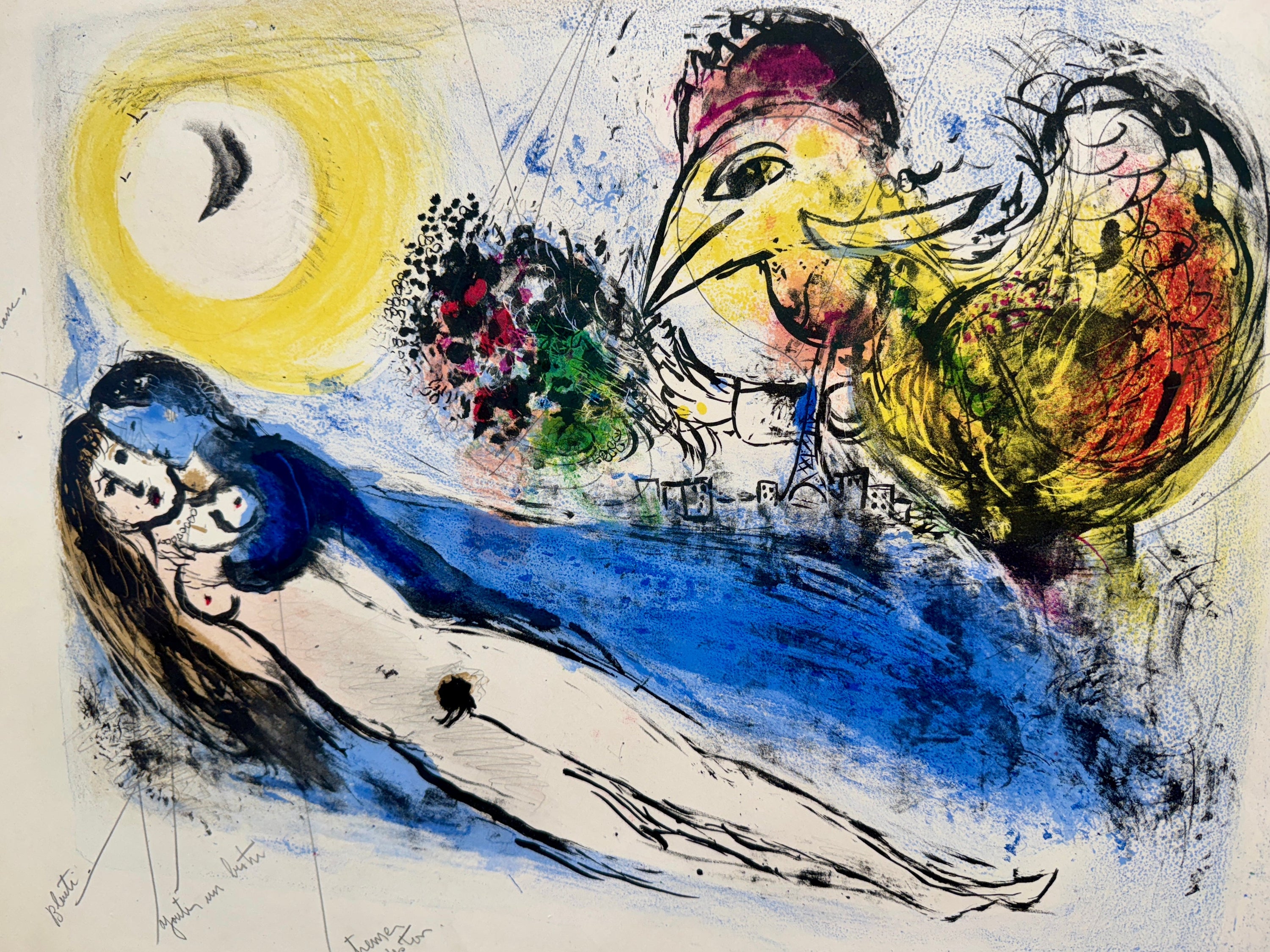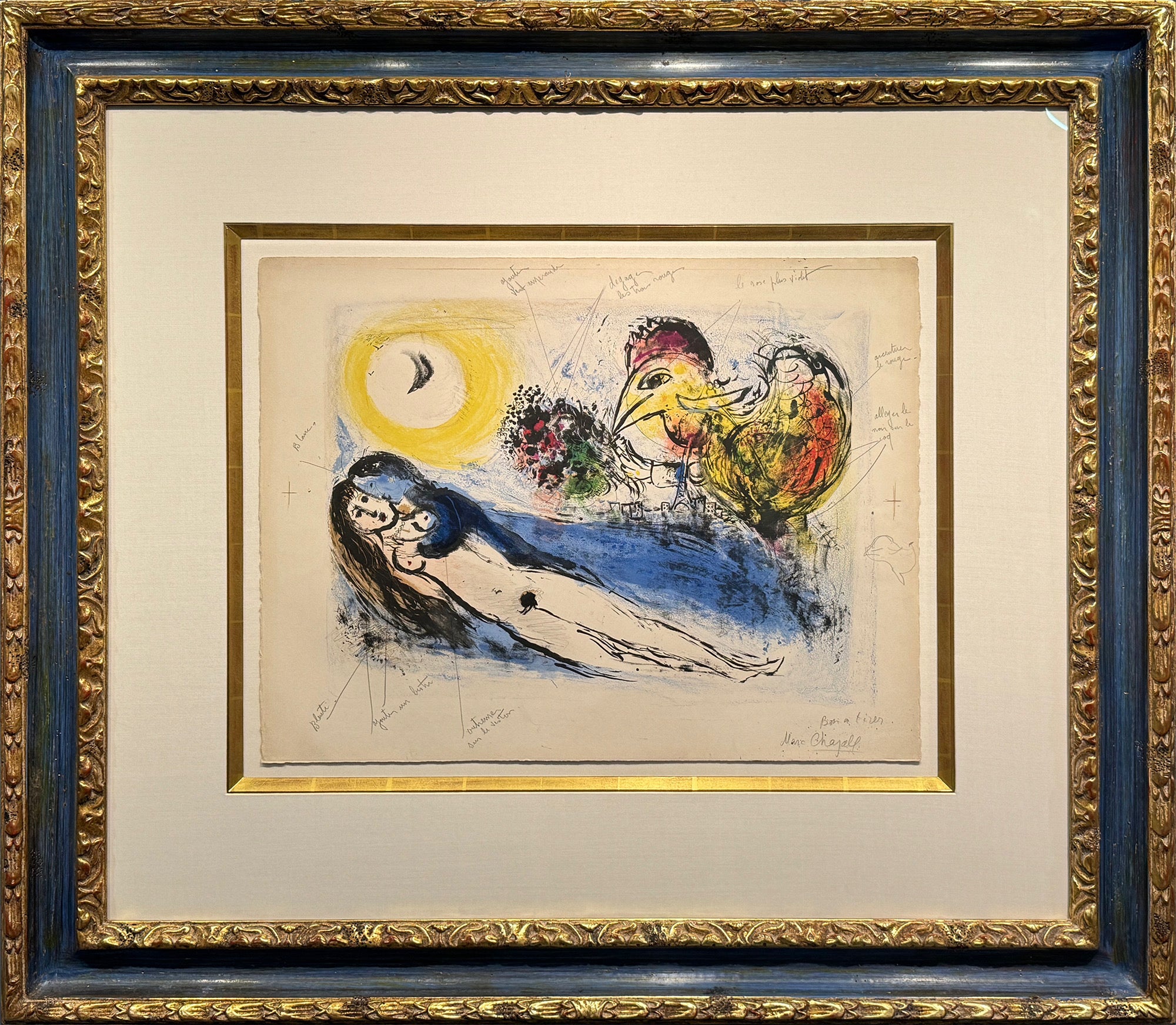Marc Chagall (1887–1985) was a Belarusian-French artist known for his dreamlike, whimsical paintings that blended folk art, Cubism, and Surrealism. His work, deeply influenced by Jewish heritage, love, and nostalgia, featured floating figures, vibrant colors, and fantastical scenes, as seen in I and the Village (1911) and The Birthday (1915). A pioneer of modern art, Chagall created paintings, stained glass, and murals, leaving a lasting legacy that bridges tradition and avant-garde expression.
-
Early Life and Education (1887–1910)
Marc Chagall was born Moïche Zakharovich Shagal on July 7, 1887, in Vitebsk, Belarus, then part of the Russian Empire. He was the eldest of nine children in a devout Jewish family. His father worked in the herring trade, while his mother managed a small shop. Despite restrictive policies on Jewish education in Russia, Chagall’s mother secured him a place at a local Russian school, where he was first exposed to art.
His early artistic training began in 1906 with a local painter, Yehuda Pen, but he soon sought broader influences. In 1907, he moved to St. Petersburg, where he studied at the Imperial Society for the Encouragement of the Arts and later at the Zvantseva School of Drawing and Painting under Léon Bakst, a major figure in the Russian avant-garde. During this period, Chagall was exposed to emerging modernist styles, but he retained a deep connection to his Jewish heritage and childhood memories, which became recurring themes in his work.
Move to Paris and Artistic Development (1910–1914)
In 1910, Chagall moved to Paris, then the epicenter of modern art. He settled in La Ruche, an artists' commune, where he met Guillaume Apollinaire, Robert Delaunay, and Fernand Léger. Paris introduced him to Cubism, Fauvism, and Surrealism, but Chagall maintained a personal, dreamlike aesthetic rather than fully adopting any particular style.
During this time, he created some of his most iconic early works, including:• I and the Village (1911) – A surreal, fragmented depiction of his hometown and rural life.
• Paris Through the Window (1913) – A whimsical, dreamlike portrayal of the city.
• Self-Portrait with Seven Fingers (1913) – A nod to his Jewish heritage and artistic aspirations.
Though he found recognition in avant-garde circles, financial hardship forced him to return to Vitebsk in 1914, intending it to be a brief visit.
World War I and Russian Period (1914–1922)
World War I broke out, stranding Chagall in Russia. He married Bella Rosenfeld, his lifelong muse, in 1915, and their deep love inspired many of his later works. During this time, he painted portraits of Bella and scenes of Jewish life, blending personal and folkloric imagery.
After the Russian Revolution of 1917, Chagall was appointed Commissar for Art in Vitebsk, where he founded an art school. However, conflicts with Kazimir Malevich and other avant-garde artists led him to leave the school and move to Moscow in 1920. He designed sets for the Jewish Theater and illustrated Yiddish literature, further solidifying his connection to Jewish culture.
Chagall left Soviet Russia in 1922, disillusioned by increasing artistic restrictions, and moved to Berlin before settling in Paris in 1923.
Paris and International Success (1923–1941)
In Paris, Chagall worked on book illustrations, including a famous series for Nikolai Gogol’s Dead Souls and La Fontaine’s Fables. In 1931, he visited Palestine, which deepened his spiritual and biblical themes. This led to his famous Bible illustrations, which he completed in the late 1930s.
However, with the rise of Nazi Germany, Chagall, as a Jewish artist, faced increasing danger. His work was labeled “degenerate art” by the Nazis, and he was forced to flee France in 1941 with the help of Varian Fry, an American journalist who helped rescue artists from Nazi-occupied Europe.
Exile in the United States (1941–1948)
Chagall settled in New York City, where he was warmly received. During this time, he designed ballet and opera sets, but his work took on a somber tone due to the Holocaust. In 1944, his beloved wife Bella died suddenly from a viral infection, devastating him.
Despite this loss, Chagall continued to work, and in 1946, the Museum of Modern Art (MoMA) held a major retrospective of his work. In 1948, he returned to France, though the scars of war and Bella’s death remained.
Post-War Period and Monumental Works (1948–1985)
Back in France, Chagall moved to the French Riviera and entered one of the most productive periods of his career. He began creating stained glass, murals, ceramics, and large-scale public works.
Some of his most famous post-war projects include:• Stained glass windows for the Metz Cathedral (1958)
• Ceiling of the Paris Opéra Garnier (1964) – A masterpiece blending homage to great composers with his signature dreamlike style.
• The “Peace” Window at the United Nations Headquarters (1964)
Stained glass windows for the Hadassah Medical Center in Jerusalem (1962–1965)
Chagall also remarried in 1952, to Valentina "Vava" Brodsky, who supported his later career. His reputation soared, and he received numerous awards, including the Grand Cross of the Legion of Honor from France.
He continued working into his late years, producing paintings, mosaics, and tapestries that reflected his lifelong themes of love, nostalgia, spirituality, and Jewish heritage.
Death and Legacy (1985–Present)
Marc Chagall passed away on March 28, 1985, at the age of 97, in Saint-Paul-de-Vence, France. He was buried in a small cemetery in the south of France.
His artistic legacy is vast, influencing generations of modern artists. His works remain housed in major museums worldwide, including:The Louvre (Paris)
The Museum of Modern Art (New York)
The Centre Pompidou (Paris)
The Tate Modern (London)
Chagall’s ability to fuse folk traditions, modernist experimentation, and deeply personal themes makes him one of the most celebrated and unique artists of the 20th century. His whimsical, poetic style, full of floating figures and dreamlike visions, continues to captivate audiences, embodying a world where love, faith, and imagination reign supreme.







